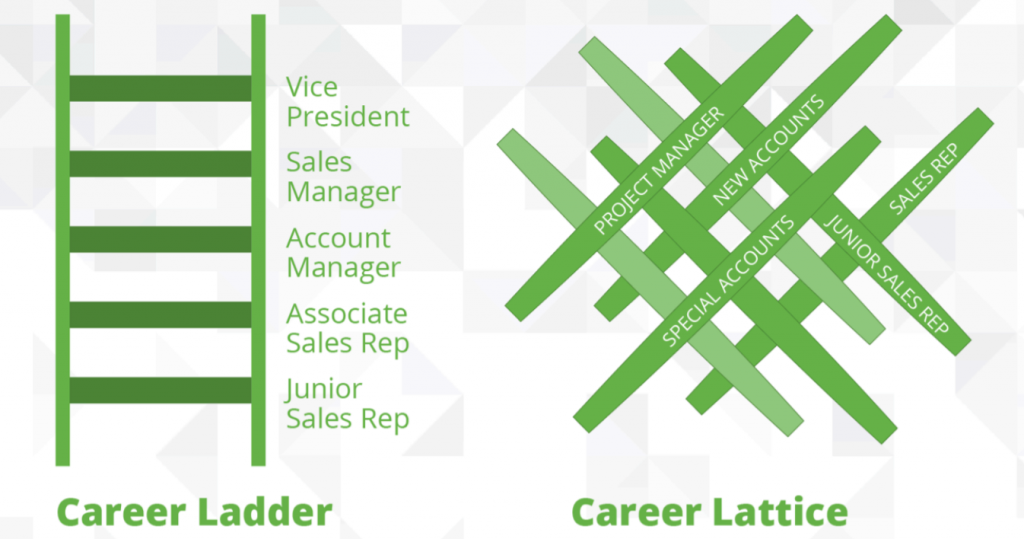In today’s job market, you need to ensure you’re investing in your employees, so you can retain them. However, the problem seems to be that companies aren’t great at creating career paths for employees to move throughout the company, so great talent is leaving the organization.
According to a Job Satisfaction Survey by the Conference Board, less than half (48%) of employees are satisfied with the career advancement opportunities available to them.
With people leaving for career advancement with other companies, you’re left to hire externally or promote from within. Promoting from within saves money that would have been spent on recruiting and training efforts, and since the employee has already been introduced to the company culture, products and services, and processes, their ramp up time is much shorter.
Let’s dive into what career pathing is, the benefits, and how to get started.
What Is Career Pathing?
A career path is a sequence of jobs an employee plans to attain during their time at an organization. The path maps out roles, skills, and competencies needed to attain each job.
Managers should sit down with each employee and map out where they would like to be in the future and explore career advancement opportunities with them.
Benefits of Career Pathing
Career pathing may take some time to get started at your company, but it can have several benefits, including:
- Employee engagement: Employees will feel more engaged when they can grow and learn new skills.
- Employee retention: Retain more employees by showing that the organization has a plan for movement and growth.
- Address employee skill gaps: Employees who realize their potential career paths gain valuable insights into several areas of their performance, including existing skills and competency gaps they should address prior to the next step in their career.
- Succession planning: Retained employees will have the experience they’ve gained by learning new skills and could then have opportunities to apply for openings within the company when other employees leave.
- Stronger understanding of cross-departmental functions: When employees shift into new roles or departments, they gain a wider understanding of how individual parts of the business can be better aligned to the overall organization’s goals.
Types of Career Growth: Ladder Vs. Lattice
Growing a career within a company usually occurs one of two ways: ladder career growth or by lattice career growth.

Ladder: This narrower, vertical view focuses primarily on getting a promotion, so the employee can attain the next job title.
Many refer to it as a ladder because it only goes up, but it could also be envisioned as a pyramid with many people at the bottom and fewer and fewer as it goes higher up.
Lattice: The lattice is the horizontal career growth path that broadens knowledge and creates value for the employee.
A horizontal move doesn’t always correlate to higher status. Most often a move across the career lattice means transferring to a different department where the employee widens their skillset by learning new skills and reskilling their existing ones.
BizLibrary can work with you to develop a training program to focus on employee reskilling and upskilling, so they can continue to grow in their careers, vertically or horizontally. As an L&D professional, utilizing learning initiatives and career pathing software allows administrators to easily build and manage curriculums for new hire onboarding or for veterans to brush up on new skills. Learning initiatives track progress and create learning plans and structured programs for employees.
Creating Opportunity for Career Growth in Your Organization
Upskilling and reskilling are the key to employee growth. Each employee’s career path may look different, but the beginning steps are often the same:
- Create an organizational chart of all company positions.
- Write job descriptions for each role in the roadmap. Included in the job descriptions should be the responsibilities of the role, the skills needed, and the requirements of the job.
- Define KPIs. Determine how success in the role will be measured, as well as what projects will need to be completed before moving into the next role.
- Incorporate L&D. Learning and development teams should be included in creating career advancement opportunities. These initiatives could include identifying key training and development milestones, helping build EQ, improving soft skills, increasing job-specific performance, helping create coaches and coachability, and improving leadership and management skills.
If this process sounds daunting to you, we’ve got great news! Our online training platform comes equipped with built-in upskilling & reskilling features that will make generating personalized learning plans for every employee not only possible, but effortless.
These AI-powered features use our extensive library of job roles that have been pre-mapped to relevant skills and content, making it simple for you to provide clear learning plans to your employees, and for them to see how their career could grow with your organization.
Inform Employees of Career Growth Options
Once your organization’s potential career paths have been created, work on upskilling and reskilling your organization and encourage managers to talk to their employees about possible growth opportunities. A great time to do so is during employee-manager one-on-ones.
Managers should ask employees questions such as, “Where do you see yourself in a year? In five?” Encourage managers to talk with their team members about any short-term goals they have as well, look at the career paths available, and create a roadmap.
Using Career Growth Opportunities for Recruiting and Hiring
Having potential career paths outlined helps attract talented employees. They will be more interested and engaged from the start if they know there are options for movement and growth at work.
Check out this brief video to learn more about using career growth and upskilling to recruit and retain top talent!
Giving employees a roadmap to grow, whether it be vertically or horizontally, sets organizations up for success. For more information on how to create a roadmap for future leaders, read our ebook on succession planning.
